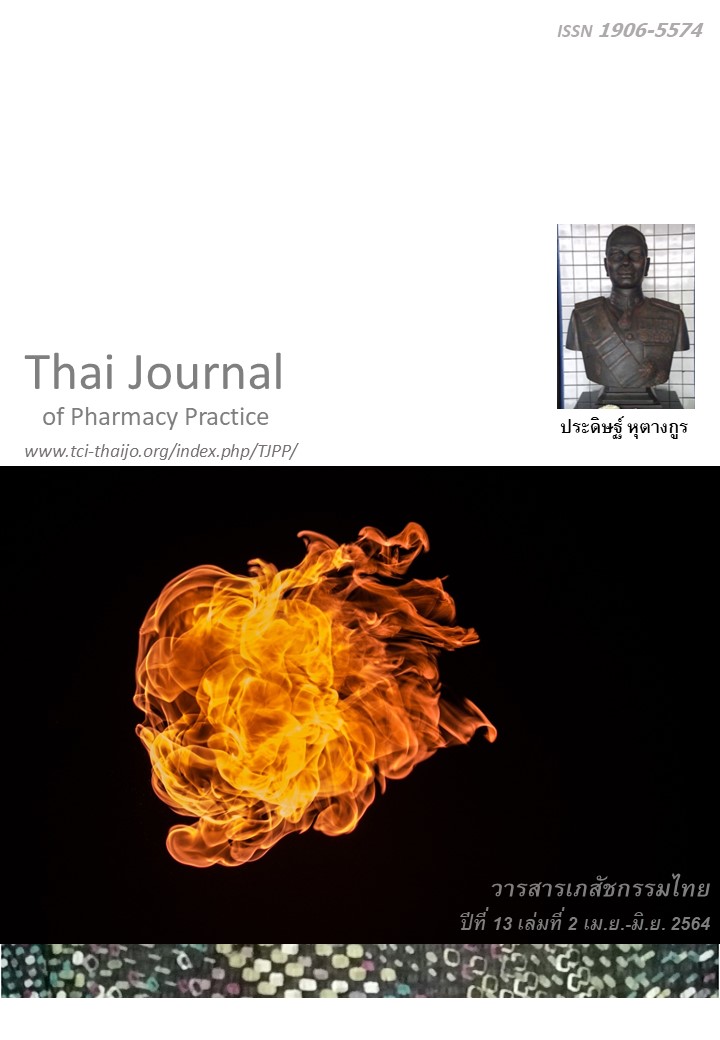ผลของการปฏิบัติตามแนวทางเวชปฏิบัติการติดตามการใช้ยากลุ่มยับยั้ง แองจิโอเทนซิน คอนเวอร์ติงเอนไซม์และยากลุ่มขัดขวางตัวรับแองจิโอเทนซิน ในผู้ป่วยโรคไตเรื้อรัง โรงพยาบาลเลาขวัญ จังหวัดกาญจนบุรี
Main Article Content
บทคัดย่อ
วัตถุประสงค์: เพื่อเปรียบเทียบระยะปลอดเหตุการณ์การหยุดยากลุ่ม ACEIs (angiotensin converting enzyme inhibitors) หรือยากลุ่ม ARBs (angiotensin receptor blockers) ของผู้ป่วยที่ได้รับการติดตามการใช้ยาทั้งสองกลุ่มดังกล่าวตามแนวทางเวชปฏิบัติครบถ้วนและผู้ป่วยที่ได้รับการติดตามอย่างไม่ครบถ้วน เพื่อประเมินปัจจัยที่ส่งผลต่อการปฏิบัติตามตามแนวทางเวชปฏิบัติฯ และเพื่อสำรวจการเปลี่ยนแปลงการทำงานของไตในผู้ป่วยโรคไตเรื้อรังที่รับยากลุ่ม ACEIs หรือ ARBs วิธีการ: ผู้วิจัยเก็บรวบรวมข้อมูลย้อนหลังจากเวชระเบียนผู้ป่วยนอกเป็น ระยะเวลา 2 ปีในผู้ป่วยโรคไตเรื้อรังที่ได้รับยากลุ่ม ACEIs หรือ ARBs ที่โรงพยาบาลเลาขวัญ จังหวัดกาญจนบุรี จำนวน 213 ราย ผู้ป่วยแบ่งเป็น 2 กลุ่ม คือ ผู้ป่วยที่ได้รับการปฏิบัติตามแนวทางเวชปฏิบัติการติดตามการใช้ยากลุ่ม ACEIs หรือ ARBs ครบถ้วนจำนวน 70 คนและผู้ป่วยที่ได้รับการปฏิบัติตามแนวทางดังกล่าวไม่ครบถ้วนจำนวน 143 คน ผลการวิจัย: ผู้ป่วยที่ได้รับการติดตามการใช้ยาทั้งสองกลุ่มตามแนวทางเวชปฏิบัติครบถ้วนมีระยะปลอดเหตุการณ์มากกว่ากลุ่มผู้ป่วยที่ได้รับการติดตามอย่างไม่ครบถ้วน อย่างมีนัยสำคัญทางสถิติ (OR=0.62, 95%Cl=0.33-0.72, P =0.048) ผู้ป่วยทั้ง 2 กลุ่มส่วนมากมีระยะของโรคไตเรื้อรังคงที่ กลุ่มผู้ป่วยที่ได้รับการติดตามการใช้ยาตามแนวทางเวชปฏิบัติครบถ้วน มีอัตราการกรองของไตลดลงน้อยกว่ากลุ่มที่ได้รับการติดตามอย่างไม่ครบถ้วน (P=0.139) กลุ่มผู้ป่วยที่ได้รับการติดตามครบถ้วน มีระดับโพแทสเซียมในเลือดเพิ่มขึ้นน้อยกว่ากลุ่มที่ได้รับการติดตามอย่างไม่ครบถ้วน (P=0.860) ยาที่ผู้ป่วยได้รับร่วมคือ ยา beta blocker ส่งผลต่อการปฏิบัติตามตามแนวทางเวชปฏิบัติการติดตามผลการใช้ยากลุ่ม ACEIs หรือ ARBs ของผู้ป่วยโรคไตเรื้อรังอย่างมีนัยสำคัญทางสถิติ (P=0.010) สรุป: การปฏิบัติตามแนวทางเวชปฏิบัติการติดตามการใช้ยากลุ่ม ACEIs หรือ ARBs ช่วยให้ผู้ป่วยได้รับยากลุ่ม ACEIs หรือ ARBs อย่างต่อเนื่องได้นานยิ่งขึ้น
Article Details
ผลการวิจัยและความคิดเห็นที่ปรากฏในบทความถือเป็นความคิดเห็นและอยู่ในความรับผิดชอบของผู้นิพนธ์ มิใช่ความเห็นหรือความรับผิดชอบของกองบรรณาธิการ หรือคณะเภสัชศาสตร์ มหาวิทยาลัยสงขลานครินทร์ ทั้งนี้ไม่รวมความผิดพลาดอันเกิดจากการพิมพ์ บทความที่ได้รับการเผยแพร่โดยวารสารเภสัชกรรมไทยถือเป็นสิทธิ์ของวารสารฯ
เอกสารอ้างอิง
Coresh J, Selvin E, Stevens LA, Manzi J, Kusek JW, Eggers P, et al. Prevalence of chronic kidney disease in the United States. J Am Med Assoc. 2007; 298: 2038-47.
National Kidney and Urologic Diseases Information Clearing House. Kidney disease statistics for the United States. NIH Publication. 2012; 12: 1-16.
Ingsathit A, Thakkinstian A, Chaiprasert A, Sangtha wan P, Gojaseni P, Kiattisunthorn K, et al. Preva lence and risk factors of chronic kidney disease in the Thai adult population: Thai SEEK study. Nephrol Dial Transplant. 2010; 25: 1567-75.
Ministry of Public Health. Guideline for health service plan development, renal [online]. 2013 [cited Aug 17, 2015]. Available from: www.kkpho.go.th/homes/inde x.php/downloads/doc_download/772--2556.htm
Go AS, Chertow GM, Fan D, McCulloch CE, Hsu D. Chronic kidney disease and the risks of death, cardiovascular events, and hospitalization. N Eng J Med. 2004; 351: 1296-305.
Chang YT, Hwang JS, Hung SY, Tsai MS, Wu JL, Sung JM et al. Cost-effectiveness of hemodialysis and peritoneal dialysis: a national cohort study with 14 years follow-up and matched for comorbidities and propensity score. Sci Rep. 2016; 6: 1-12.
Kidney Association of Thailand. Clinical practice recommendation for the evaluation and manage ment of chronic kidney disease in adults 2015. [online] 2015. [cited Aug 17, 2015]. Available from: www.nephrothai.org/images/10-11-2016/Final_%E0 %B8%84%E0%B8%A1%E0%B8%AD_CKD_2015.pdf.
Kidney Disease: Improving Global Outcomes (KDIGO) CKD Work Group. KDIGO 2012 clinical practice guideline for the evaluation and manage ment of chronic kidney disease. Kidney inter 2013; 3: 1–150.
National Kidney Foundation. K/DOQI clinical practice guidelines on hypertension and antihypertensive agents in chronic kidney disease. Am J Kidney Dis. 2004; 43: S183-205.
Barnett AH, Bain SC, Bouter P, Karlberg B, Mads bad S, Jervell J, et al. Angiotensin-receptor blockade versus converting-enzyme inhibition in type 2 diabetes and nephropathy. N Eng J Med. 2004; 351: 1952-61.
Daengratsamisophon T, Alisanan A, Tangkiatkam chai M and Phokhaiwanitkun T. Monitoring serum creatinine and blood potassium of patient taking ACEIs and/or ARBs: case study of chronic renal disease and diabetes patients. Thai Journal of Hospital pharmacy. 2007; 17: S58-65.
Panawong W. Compliance with treatment guideline for mineral and bone disorder in chronic kidney disease [master thesis]. Khon Kaen: Khon Kaen University; 2010.
Qin D, Leef G, Alam MB, Rattan R, Munir MB, Patel D, et al. Patient outcomes according to adherence to treatment guidelines for rhythm control of atrial fibrillation. J Am Heart Assoc. 2015; 4: 1-9.
Wang PT, Huang YB, Lin c MN, Chuang PF, Hwang SJ. Prescriptions for angiotensin-converting enzyme inhibitors/angiotensin receptor blockers and monitoring of serum creatinine and potassium in patients with chronic kidney disease. Kaohsiung J Med Sci. 2012; 28: 477-83.
Ong-ajyooth L, Vareesangthip K, Khonputsa P, Aek plakorn W. Prevalenceof chronic kidney disease in Thai adults : a national health survey. BMC Nephrol. 2009; 10: 35-41.
Schmidt M, Mavsfield KE, Bhaskaran K, Nitsch D, Sorensen HT, Smeeth L, et al. Adherence to guide lines for creatinine and potassium monitoring and discontinuation following renin–angiotensin system blockade: a UK general practice-based cohort study. BMJ Open. 2016; 10: 1-11.
Lewis EJ, Hunsicker LG, Clarke WR, Berl T, Pohl MA, Lewis JB, et al. Renoprotective effect of the angiotensin-receptor antagonist irbesartan in patients with nephropathy due to type 2 diabetes. N Eng J Med. 2001; 345: 851-60.
Chan GC, Tang SC. Diabetic nephropathy: land mark clinical trials and tribulations. Nephrol Dial Transplant. 2016; 31: 359-68.
Ongkharuyanon S. Development of self-care behavior in kidney disease patients at Chaophraya yommarat hospital Suphanburi. Journal of Public Health Development 2008; 6:32-8.
Raebel MA, McClure DL, Simon SR, Chan KA, Feldstein A, Andrade SE, et al. Laboratory monitoring of potassium and creatinine in ambulatory patients receiving angiotensin converting enzyme inhibitors and angiotensin receptor blockers. Pharmacoepidemiol Drug Saf. 2007; 16: 55-64.


